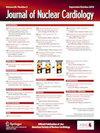Quantification of metabolic activity in the evaluation of cardiac sarcoidosis
IF 3
4区 医学
Q2 CARDIAC & CARDIOVASCULAR SYSTEMS
引用次数: 0
Abstract
Sarcoidosis is a systemic disorder characterized by non-necrotizing granulomatous inflammation and fibrosis affecting multiple organs, notably the lungs and lymph nodes. Cardiac sarcoidosis (CS), a subset of the disease predominantly involving the heart, significantly heightens the associated morbidity and mortality of sarcoidosis. Early detection of CS is crucial for optimal management. Positron emission tomography/computed tomography (PET/CT) using 18F-fluorodeoxyglucose (18F-FDG) has emerged as an important diagnostic, prognostic, and monitoring tool for CS. Guidelines emphasize a combined approach of visual interpretation and adjunctive quantitative metrics to enhance diagnostic accuracy and treatment monitoring. Various quantitative parameters including maximum standardized uptake value (SUVmax), coefficient of variation, and texture analysis show promise as auxiliary tools diagnosing and prognosticating CS. However, standardization and validation of these quantitative methods remain challenging due to inter-center variability and technological differences. Further validation through large-scale, multi-center studies is needed to optimize their use and better delineate their role in CS diagnosis, prognostication, and therapy monitoring.
评估心脏肉瘤病时的代谢活动定量。
肉样瘤病是一种全身性疾病,其特征是非坏死性肉芽肿性炎症和纤维化,影响多个器官,尤其是肺部和淋巴结。心脏肉样瘤病(CS)是主要累及心脏的疾病的一个分支,大大增加了肉样瘤病的相关发病率和死亡率。早期发现心脏肉样瘤病对于优化治疗至关重要。使用 18F- 氟脱氧葡萄糖(18F-FDG)的正电子发射断层扫描/计算机断层扫描(PET/CT)已成为 CS 重要的诊断、预后和监测工具。指南强调采用肉眼判读和辅助定量指标相结合的方法,以提高诊断准确性和治疗监测效果。包括最大标准化摄取值(SUVmax)、变异系数和纹理分析在内的各种定量参数有望成为诊断和预后 CS 的辅助工具。然而,由于中心间的差异和技术上的不同,这些定量方法的标准化和验证仍具有挑战性。需要通过大规模、多中心研究进一步验证,以优化这些方法的使用,并更好地界定它们在 CS 诊断、预后和治疗监测中的作用。
本文章由计算机程序翻译,如有差异,请以英文原文为准。
求助全文
约1分钟内获得全文
求助全文
来源期刊
CiteScore
5.30
自引率
20.80%
发文量
249
审稿时长
4-8 weeks
期刊介绍:
Journal of Nuclear Cardiology is the only journal in the world devoted to this dynamic and growing subspecialty. Physicians and technologists value the Journal not only for its peer-reviewed articles, but also for its timely discussions about the current and future role of nuclear cardiology. Original articles address all aspects of nuclear cardiology, including interpretation, diagnosis, imaging equipment, and use of radiopharmaceuticals. As the official publication of the American Society of Nuclear Cardiology, the Journal also brings readers the latest information emerging from the Society''s task forces and publishes guidelines and position papers as they are adopted.

 求助内容:
求助内容: 应助结果提醒方式:
应助结果提醒方式:


